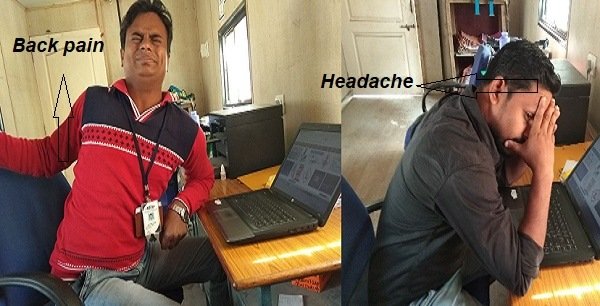Contents
Advantages of computerized information systems are: –
- Data standardization and accuracy.
- Improved analytical capabilities. Analyses not manually practical, can be easily done by a computer Graphs and Charts also available.
- Cost savings by increasing employee productivity, decreasing manpower etc.
- Ready availability of data and ready reproduction (printed copy) of the stored data.
- Elimination of monotonous or exhaustive manual labor.
- No need to keep duplicate records (copies).Reducing files and their storing Space.
- Improved communication with neat, clean and correct copies Electronic mail systems can facilitate communication within and between hide facilities and within short time.
Disadvantages (limitations) of computer information systems are –
- According to circumstances, need of co is not always justified. Sometimes it premature or totally unjustified one grounds.
- Computers’ limitations should be and they are not designed for automatic information generation or processing. an operator. Required to make data-entry or supp information (programmer) to computers error can give wrong or incomplete info or sometimes erase it and manual becomes necessary. Mistakes can repetitive if not corrected in time. ‘
- Computers can suggest references to doc They cannot eliminate the need to go these documents to locate the re information.
- A typical virus can wash out all info stored in the computer. Then retrieval restoration of data becomes necessary.
- Manpower reduction for unemployment.
CLICK HERE FOR ? Compilation, Collation & Analysis of Hazard Information
Hazards and Controls of Working on Computer:
Following hazards have been reported:
- A study report of Devis School of Me California, USA, says that pain in shoulders and neck, tension on eyes an pain due to decreased blood-circulation all ill effects of constantly sitting on key Long sitting in particular posture is hazards to health Ergonomic design of sitting working arrangement and training to co Operator are essential to reduce such (News l 1-1-2000),
- Ergonomic problems may arise with co operators. Computer room should not noisy, too warm, too cold, unpleasant, congested or poorly lighted. Worryingly furniture and sitting arrangement can pain in neck and back
- Radiation from screen (VDU) and bad can cause eye fatigue and headache screen or auto glare (strain) removal the useful.
- Psychological problems like monotonous in isolated position, waiting times, concentration (e.g. traffic control) may also Good design and layout of computer equipment, fire protection system, protection, utilities protection and safe practices are necessary.
- It is also reported that using a computer for a long time exposes some people to carpal tunnel pressure levels that may lead to repetitive strain injury to the wrist and hand this was said by David Rampel, Director of the Ergonomics Program at UC San Francisco (News, Bridges, COEH, June 2000).
- It is reported that increased use of computers will develop cataract at the younger age and in the year 2050, most of the people will be able to read on the computer only after laser surgery (News 238-2000).
- One study report in California revealed that the women working more than 20 hours in a week on video display unit have 8000 more chances of abortion than those not working in this way.
- Another survey in western countries states that 10 to 15% employees working on computers daily complain of body pain and eye strain. Other 40 to 50° 0 employees complain occasionally.
CLICK HERE FOR ? MANAGEMENT INFORMATION SYSTEM (MIS) FOR SAFETY
As per one Japanese study, eye flickering reduces lo 7/min. from the normal level of 22/min. Eye-watering, burning, temporary dimness or vision lose, to se double things etc. are known ’as ‘Computer vision syndrome (CVS).
- Indian people are habituated to work in 27°C temperature. If they are compelled to work in 17 to 23°C temp, CVDT operators), their health is adversely affected.
Control Measures:
Ergonomics suggest. Many remedial measures to reduce ‘computer-trauma’ and other health effects. Some of them are as under:
- Computer Vision Syndrome (CVS) Eyestrain is mainly due to monochromatic light or burden of glare (excessive light) on eye. Pain in neck or back is caused due to improper seating of monitor from our face. The monitor should be kept at 10 to 15° below the angle 0 eye level and 20 to 28 inch away from the face. There should be a balance between
- Monitor light and room light. In the darkness, the computer should not be Operated Eyes should be turned aside and closed for a few seconds at the interval of half an hour a vision guard programmer is available to remind this relaxation exercise. It should be loaded in the computer.
- Hand below the elbow should remain parallel on computer-table, and fingers on the keyboard.
- Table and chair should be fully flexible so as to rearrange as requirement. Specially designed backrest necessary.
- VDU should be so placed that the sight will fall on the correct place on the screen Computer screen should remain below the eyes so that the eyes and neck are not 1′; unnecessarily raised.
- Noise from printer should not be more than 55 dB, otherwise, hood is required.
- 7 Operators having sifting work and standing work should be interchanged by job rot This will relax the contracted muscles maintain the body tone-up.
- 8 Eyes should be examined by Ophthalmologist for internal defects if any after the age spectacles become necessary to see from a distance. Considering the length between eyes and the computer screen, the sp spectacles (not bi-focal) should be worn working on ‘ computer.
- Lighting, shining and color have also effects. They should not be excessive.
- At every 15 to 30 minutes, eyes should be turned away from the screen to see aside or take raise or move hands, press fingers etc. should be freed from one position. They have rest support.
- Working hours on the computer should be re with increasing age or difficulty.
Causes of MIS failure:
They are of the following types:-
- Insufficient, incorrect or ambiguous information.
- No two-way communication.
- Confused reporting.
- Poor exchange of information.
- Poor system of communication.
- Insufficient employee involvement.
- Untrained employees
- No system of feedback receiving improvement of M18.
- No advanced planning. to meet and c emergencies.
- No advance planning for protection of M Steps to prevent virus in computers, Such causes should be detected and removed as early as possible.
CLICK HERE FOR ? Modern Methods of Programming
Status & Future Goals of Computer Utilization in SHE Services:
Status of computer utilization is being increased and spreading very fast. Today we are rapidly e in the age of information technology, information highways, internet systems super-computers to scan, develop, store, exchange and transmit d many complex systems and for many purposes.
Paper tiles and record rooms are all shortened and it that in every walk of life computer has to play some role Safety, health and environment being the vital subject, cannot remain without the use of corn Process technology, instrument, and control hazard control technology, emergency.. including training, education, and information to workers, public, management and Government everywhere use of computers is being increased.
One earlier software for SHE services is CAMEO:-
Computer Aided Management of Emergency Operations. It is a Computer Software Package deve10ped by the Environment Protection Agency (EPA) of USA.
The CAMEO software is made operational and available from the National Safety Council, Mumbai. It was explained with the APELL/ CEP workshops at Manali, Mumbai, Kanpur, Cochin, Haldia, and Vadodara, from 1992 to 1995.
CLICK HERE FOR ? Computer Application use in safety management
CAMEO gives emergency planner, first responder (f1re brigade, police etc.) or safety professional Vital information to help handle chemical accidents safely What does CAMEO provide:
CAMEO provides tools to help address issues, including
- Response information for over 4000 chemicals commonly transported.
- Database templates to help manage chemical inventory information.
- A mapping capability that allows identifying the proximity and potential hazard posed by facilities to sensitive populations.
- The ability to create a scenario using hazard analysis calculations to assist in emergency planning and overlay the estimated vulnerable zone on maps.
- A drawing capability to pinpoint locations of chemicals stored in-community 0r facility floor plans that are created.
- An air dispersion model that can be used to help evaluate spill scenarios and evacuation Options for 700 airborne toxic chemicals (this features is available for the Macintosh and is being developed for CAMEO DOS).
Integration between Departmental MIS:
Because of wide use of computer software for many purposes, use of internal and external e-mail and information transfer systems, transferring presentation from any computer to the computer of conference room or auditorium, using stored or communicated information for design, production, sale, purchase, taxation, audit, assessment etc, good and effective integration of M18 between all departments is essential and constantly required.
CLICK HERE FOR ? SOP FULL FORM
Information on the safety management system, SOP, PPE, safety work permits, statutory and other safety provisions, forms and annexure, training subjects and schedules, safety suggestions, compliance etc is required by many departments from safety department Similarly safety department needs feedback and other information from other departments.
This is not possible without effective integration of M18 between all departments. Therefore continuous integration between departmental MIS should be maintained and updated.
FAQ – Advantages and Disadvantages of Computerized System
Q: What is a computerized system?
A: A computerized system is a system that uses computers or computer technology to perform various tasks and functions. It typically involves the use of software, hardware, databases, and networks to automate and manage processes.
Q: What are the advantages of using a computerized system?
A: There are several advantages to using a computerized system:
- Increased efficiency: Computerized systems can process, store, and retrieve large amounts of data quickly, allowing for faster and more accurate operations.
- Reduced human errors: Automation reduces the likelihood of human errors that can occur during manual processes.
- Improved accuracy: Computerized systems can perform complex calculations and tasks with precision, minimizing errors often associated with manual methods.
- Better data management: Computerized systems allow for centralized data storage, easy organization, and quick retrieval of information.
- Enhanced productivity: Automation can streamline processes, freeing up time and resources for other important tasks, leading to increased productivity.
Q: What are the disadvantages of using a computerized system?
A: Despite their numerous advantages, computerized systems also have some drawbacks:
- Initial setup cost: Implementing a computerized system requires a significant upfront investment in hardware, software, training, and infrastructure.
- Dependency on technology: Computerized systems rely heavily on technology, and any technical issues or system failures can disrupt operations until resolved.
- Security risks: Computerized systems may be vulnerable to security threats, such as data breaches and unauthorized access, requiring robust security measures to mitigate risks.
- Training and learning curve: Transitioning to a computerized system might require training personnel to adapt to the new technology and processes, which can involve a learning curve and potential resistance to change.
- Potential job displacement: Automation can lead to job redundancies or reassignments if certain tasks and functions are taken over by computerized systems.
Q: Can computerized systems replace human involvement completely?
While computerized systems can automate many tasks and processes, complete replacement of human involvement is often not feasible or desirable. Certain tasks still require human judgement, creativity, empathy, and critical thinking skills that computers cannot replicate. However, computerized systems can significantly augment human capabilities, allowing humans to focus on high-level decision-making and tasks that require human intuition and expertise.
PLEASE SHARE THIS ARTICLE WITH YOUR RELEVANT FRIENDS






